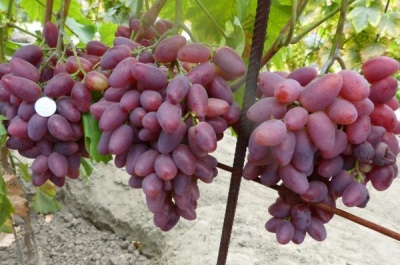
- Authors: Pysanka Oleg Mikhailovich
- Appointment: dining room
- Berry color: red-burgundy
- Taste: harmonious
- Ripening period: early
- Ripening period, days: 105-110
- Frost resistance, ° C: -23
- Name synonyms: 03-33
- Bunch weight, g: 800-1000
- Flower type: functionally female
One of the most reliable fruit crops is grapes. From the third year, the bushes begin to give a stable harvest, if you provide them with proper care and timely watering. Let's talk about one of these varieties - Polonez-50.
Breeding history
Polonaise-50 appeared thanks to the painstaking work of the breeder of Pisanka Oleg Mikhailovich. He crossed the Achilles and Legenda Aksai varieties.
Description
The description of this variety should start with the fact that it is a hybrid, which is still not widespread in our country. The bushes are characterized by great vigor. Flowers of the female type are formed on them. Up to 2 inflorescences are formed on each shoot. The plant does not require normalization.
Purpose - dining room.
Ripening period
The fruits ripen in 105-110 days. Thus, this variety belongs to the early ones.
Bunches
The bunches are distinguished by a cylindrical-conical shape. The density of the berries can be characterized as loose or medium. The weight of each bunch can vary from 800 to 1000 g.
Berries
Ripe fruits have a shade of red with a burgundy tint. Gardeners appreciate Polonez-50 for its thin skin and pulp, the consistency of which is similar to marmalade. The fruit is ovoid, weighing 14 to 16 grams.
Taste
Polonaise-50 has a harmonious taste, so it will be a wonderful decoration for the table.
Yield
The yield, according to the observations of gardeners, can be assessed as good. There is no need for standardization.


Growing features
Since the vine can live from 50 to 100 years, you need to choose a place where the seedlings can stay indefinitely. This plant loves the sun, so choosing the right place is extremely important.
Inhabitants of the Northern Hemisphere should choose the southern side of the site. For the inhabitants of the Southern Hemisphere, the opposite is true.
A trellis or any other type of support structure should be used.
Landing
You will need at least 1.5 meters of free space between the plants. With mechanical post-processing, even more space is required. Thus, it is possible to obtain the necessary space for the development of roots.
Begin by preparing a pit with a width and depth of at least 40 cm. Add drainage and a layer of fertile soil with fertilizers to the bottom. Then place the vine in the soil, cover it up to half with soil, compact it tightly, then add the remaining soil to completely fill the hole. The last layer is not tamped.
Cut off the top, leave a few buds (2-3 is optimal) and water thoroughly.

Pollination
Pollination is required. If it is of poor quality, then the berries are obtained on a bunch of different sizes.
Pruning
Pruning is required in the fall. Sick and old shoots are removed. When planting, the vine is cut back by 3 or 4 eyes, and the roots are well shortened. In the second year of growing grapes, the vine should be pruned to the same number of eyes as in the first year. After growth begins in spring, the two strongest buds are left.

Watering
Determining the right amount of water for growing grapes can be tricky. The soil should be moist, but not soggy, as the plant can quickly become sick.
Although grapes are somewhat drought tolerant, they tend to produce fewer fruits when under water stress. Providing it with the right amount of water is very important if you want to get a large harvest.
Most gardeners choose drip irrigation systems. Mulching around the plants also helps maintain adequate moisture, especially during the hot summer months. In addition, mulch reduces the development of weeds.
In the first year, water at least once a week until the soil is moist to a depth of 6-10 cm around the roots of the plant. In subsequent years, once a week until the ground is soaked 12 cm below the surface of the soil.


Top dressing
Fertilizers must be applied to the planting pit and then only in the second year. These can be organic compounds such as horse manure and chicken manure, as well as ready-made mineral supplements.
Frost resistance and the need for shelter
Frost resistance is -23 degrees. This grape grows well in the south and in the central part of the country. In regions with severe frosts, additional cover with spruce branches or agromaterial is required.

Diseases and pests
Fungicides do an excellent job with diseases and pests. Finding the drug you need is not difficult on the shelf of a specialized store. You can use copper sulfate or garlic infusion.

If a grape is exposed to any disease or insect, this always affects its appearance.
Storage
The berry is stored in suitable conditions for about a week.











































































